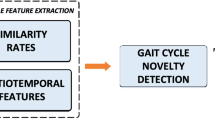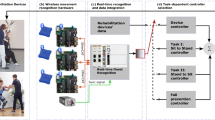Abstract
The wearable powered exoskeletons have obtained great interest in enhancing the ability of people to perform heavy physical labor (e.g., soldiers transporting military supplies in high altitude areas and couriers carrying express goods in the logistics industry). A key problem we care about is how to make the exoskeletons provide efficient aids for people in complex environment (e.g., different terrains, different speeds, and different payloads), and the exoskeletons controller system needs the gait phase information reflecting people’s walking state for creating aids for people. There are two main methods of gait phase detection, which are model-based and distance-based methods. Model-based approaches describe data distribution by employing discriminative (e.g., support vector machines (SVMs), recurrent neural networks (RNNs) and convolutional neural networks (CNNs)) and generative (e.g., hidden Markov models (HMMs) and Gaussian models) models. Distance-based approaches match locomotion pattern with reference sets by employing distance measures, such as dynamic time warping (DTW). The distance-based method during training is better when the available data is limited, because the model-based method will face the problem of over-fitting. This study proposes an online gait detection method based on distance and multi-sensors information fusion to solve the gait phase detection problem in complex environment. In addition, considering the force sensitive resistors (FSRs) limited lifespan, we adopt lower extremity angles measured by the IMU sensors as the input signal of the method for improving the performance. The results show that the method can adaptively detect the gait phase in real time for different terrains and different payloads while walking at different speeds. Our proposed method can gain over 95% accuracy and time difference is 4.99 ± 15.05 ms.


















Similar content being viewed by others
References
Wang L, Ning H, Tan T, Hu W (2004) Fusion of static and dynamic body biometrics for gait recognition. IEEE Trans Circuits Syst Video Technol 14(2):149–158. https://doi.org/10.1109/TCSVT.2003.821972
Pappas IP, Popovic MR, Keller T, Dietz V, Morari M (2001) A reliable gait phase detection system. IEEE Trans Neural Syst Rehabil Eng. https://doi.org/10.1109/7333.928571
Fong T, Kunz C, Hiatt LM, Bugajska M (2006) The human-robot interaction operating system. In: Proceedings of the 1st ACM SIGCHI/SIGART conference on Human-robot interaction, HRI 2006, Salt Lake City, Utah, USA, PP. 41–48
Kong K, Tomizuka M (2009) A gait monitoring system based on air pressure sensors embedded in a shoe. IEEE/ASME Trans Mechatron 14(3):358–370. https://doi.org/10.1109/TMECH.2008.2008803
Mariani B, Rouhani H, Crevoisier X, Aminian K (2013) Quantitative estimation of foot-flat and stance phase of gait using foot-worn inertial sensors. Gait Posture 37(2):229–234. https://doi.org/10.1016/j.gaitpost.2012.07.012
Lopez-Meyer P, Fulk GD, Sazonov ES (2011) Automatic Detection of Temporal Gait Parameters in Poststroke Individuals. IEEE Trans Inf Technol Biomed 15(4):594–601. https://doi.org/10.1109/TITB.2011.2112773
Blanc Y, Balmer C, Landis T, Vingerhoets F (1999) Temporal parameters and patterns of the foot roll over during walking: Normative data for healthy adults. Gait & Posture, pp. 97–108. https://doi.org/10.1016/S0966-6362(99)00019-3
Jing T, Bin ZJ, Yang W, Lie Y (2018) Self-tuning threshold method for real-time gait phase detection based on ground contact forces using FSRs. Sensors 18(2):481–495
Hu H, Zheng J, Zhan E, Yu L (2019) Curve similarity model for real-time gait phase detection based on ground contact forces. Sensors 19(14):3235–3255. https://doi.org/10.3390/s19143235
Lie Yu, Zheng J, Wang Y, Song Z, Zhan E (2019) Adaptive method for real-time gait phase detection based on ground contract forces. Gait Posture 41(1):269–275. https://doi.org/10.1016/j.gaitpost.2014.10.019
Fangli Y, Zheng J, Lie Y, Zhang R, He H, Zhu Z, Zhang Y (2018) Adjustable method for real-time gait pattern detection based on ground reaction forces using force sensitive resistors and statistical analysis of constant false alarm rate. Sensors. https://doi.org/10.3390/s18113764
Martin Schepers H, van Asseldonk EHF, Baten CTM, Veltink PH (2010) Ambulatory estimation of foot placement during walking using inertial sensors. J Biomech 43(15):3138–3143
Rueterbories J, Spaich EG, Andersen OK (2013) Characterization of gait pattern by 3D angular accelerations in hemiparetic and healthy gait. Gait Posture 37(2):183–189. https://doi.org/10.1016/j.gaitpost.2012.06.029
Peruzzi A, Croce U, Cereatti A (2011) Estimation of stride length in level walking using an inertial measurement unit attached to the foot: A validation of the zero velocity assumption during stance. J Biomech 44(10):1991–1994. https://doi.org/10.1016/j.jbiomech.2011.04.035
Rueterbories J, Spaich EG, Larsen B, Andersen OK (2010) Methods for gait event detection and analysis in ambulatory systems. Med Eng Phys 32(6):545–552. https://doi.org/10.1016/j.medengphy.2010.03.007
Huang B, Chen W, Shi X, Xu Y (2007) Gait Event Detection with Intelligent Shoes. In: Proceedings of the International Conference on Information Acquisition, Seogwipo-si, South Korea, 9(11) 579–584.
Takeda R, Tadano S, Todoh M, Morikawa M, Nakayasu M, Yoshinari S (2009) Gait analysis using gravitational acceleration measured by wearable sensors. J Biomech 42(3):223–233
Schwesig R, Leuchte S, Fischer D, Ullmann R, Kluttig A (2011) Inertial sensor based reference gait data for healthy subjects. Gait Posture 33(4):673–678. https://doi.org/10.1016/j.gaitpost.2011.02.023
Kiguchi K, Hayashi Y (2012) An EMG-Based Control for an Upper-Limb Power-Assist Exoskeleton Robot. IEEE Trans Syst, Man, Cyber, Part B Cyber 42(4):1064–1071. https://doi.org/10.1109/TSMCB.2012.2185843
Li Z, Wang B, Sun F, Yang C, Xie Q, Zhang W (2014) sEMG-based joint force control for an upper-limb power-assist exoskeleton robot. IEEE J Biomed Health Inform 18(3):1043–1050. https://doi.org/10.1109/JBHI.2013.2286455
Wentink EC, Beijen SI, Hermens HJ, Rietman JS, Veltink PH (2013) Intention detection of gait initiation using EMG and kinematic data. Gait Posture 37(2):223–228. https://doi.org/10.1016/j.gaitpost.2012.07.013
Kyeong S, Shin W, Yang M, Heo U, Feng J-R, Kim J (2019) Recognition of walking environments and gait period by surface electromyography. Front Inf Technol Electr Eng 20(3):40–50. https://doi.org/10.1631/FITEE.1800601
H Lamine, S Bennour, M Laribi, L Romdhane, S Zaghloul (2017) Evaluation of Calibrated Kinect Gait Kinematics Using a Vicon Motion Capture System. In: Computer Methods in Biomechanics & Biomedical Engineering, pp.111–112
Attal F, Amirat Y, Chibani A, Mohammed S (2018) Automatic recognition of gait phases using a multiple-regression hidden Markov model. IEEE/ASME Trans Mechatron 99:1597–1607
Kale A, Cuntoor N, Yegnanarayana B, Rajagopalan AN, Chellappa R (2003) Gait analysis for human identification. In: Proceedings of the 3rd international conference on audio and video based person authentication, Springer-Verlag 706–714
Allseits E, Lučarević J, Gailey R, Agrawal V, Gaunaurd I, Bennett C (2017) The development and concurrent validity of a real-time algorithm for temporal gait analysis using inertial measurement units. J Biomech 55:27–33
Martinez-Hernandez U, Rubio-Solis A, Dehghani-Sanij AA (2018) Recognition of walking activity and prediction of gait periods with a CNN and first-order MC strategy. In: 2018 7th IEEE International Conference on Biomedical Robotics and Biomechatronics (Biorob), pp. 897–902
Sahoo S, Saboo M, Pratihar DK, Mukhopadhyay S (2020) Real-time detection of actual and early gait events during level-ground and ramp walking. IEEE Sens J 20(14):8128–8136
Huong Thi Thu Vu, Dong D, Cao H-L, Verstraten T, Lefeber D, Vanderborght B, Geeroms J (2020) A review of gait phase detection algorithms for lower limb prostheses. Sensors 20(14):3972–3990. https://doi.org/10.3390/s20143972
Jain B, Schultz D (2020) Sufficient conditions for the existence of a sample mean of time series under dynamic time warping. Ann Math Artif Intell 88(4):313–346. https://doi.org/10.1007/s10472-019-09682-2
Morel M, Achard C, Kulpa R, Dubuisson S (2017) Time-series averaging using constrained dynamic time warping with tolerance. Patt Recogn, Elsevier 74:77–89. https://doi.org/10.1016/j.patcog.2017.08.015
Brijnesh J, David S (2018) On the existence of a sample mean in dynamic time warping spaces. https://www.researchgate.net/publication/323655911
Brill M, Fluschnik T, Froese V, Jain B, Niedermeier R, Schultz D (2019) Exact mean computation in dynamic time warping spaces. Data Min Knowl Disc 33:252–291
Rakthanmanon T, Campana B, Mueen A, Batista G, Westover B, Zhu Q, Zakaria J, Keogh E (2012) Searching and mining trillions of time series subsequences under dynamic time warping. In: Proceedings of the 18th ACM SIGKDD international conference on Knowledge discovery and data mining, pp.262–270
Sánchez Manchola MD, Pinto Bernal MJ, Munera M, Cifuentes CA (2019) Gait phase detection for lower-limb exoskeletons using foot motion data from a single inertial measurement unit in hemiparetic individuals. In: Sensors p.2988. https://doi.org/10.3390/s19132988
Zakria M, Maqbool HF, Hussain T, Awad MI, Mehryar P, Iqbal N, Dehghani-Sanij AA (2017) Heuristic based gait event detection for human lower limb movement. In: Proceedings of the 2017 IEEE EMBS International Conference on Biomedical & Health Informatics (BHI), Orlando, FL, USA, pp. 337–340
Maqbool HF, Husman MAB, Awad MI, Abouhossein A, Mehryar P, Iqbal A, Dehghani-Sanij AA (2016) Real-time gait event detection for lower limb amputees using a single wearable sensor. In: Proceedings of the 2016 IEEE 38th Annual International Conference of the Engineering in Medicine and Biology Society (EMBC), Orlando, FL, USA, pp. 5067–5070
Bejarano NC, Ambrosini E, Pedrocchi A, Ferrigno G, Monticone M, Ferrante S (2015) A novel adaptive, real-time algorithm to detect gait events from wearable sensors. IEEE Trans Neural Syst Rehabil Eng 23:413–422. https://doi.org/10.1109/TNSRE.2014.2337914
Jung-Young WH, Yang H, Park H (2015) A Neural network-based gait phase classification method using sensors equipped on lower limb exoskeleton robots. Sensors 15:7738–7759. https://doi.org/10.3390/s151127738
Mannini A, Genovese V, Sabatini AM (2014) Online decoding of hidden Markov models for gait event detection using foot-mounted gyroscopes. IEEE J Biomed Health Inform. https://doi.org/10.1109/JBHI.2013.2293887
Lempereur M, Rousseau F, Rémy-Néris O, Pons C, Houx L, Quellec G, Brochard S (2020) A new deep learning-based method for the detection of gait events in children with gait disorders: Proof-of-concept and concurrent validity. J Biomech 98:9490–9494. https://doi.org/10.1016/j.jbiomech.2019.109490
Lee JK, Park EJ (2011) Quasi real-time gait event detection using shank-attached gyroscopes. Med Biol Eng Comput 49(6):707–712. https://doi.org/10.1007/s11517-011-0736-0
Acknowledgements
We wish to express our gratitude to the participants who took part in this study.
Funding
This study was funded by the National Key R&D Program of China “The study on Load-bearing and Moving Support Exoskeleton Robot Key Technology and Typical Application” (grant number 2017YFB1300502).
Author information
Authors and Affiliations
Corresponding author
Ethics declarations
Conflict of interest
The authors are with the School of Information Engineering Wuhan University of Technology, and declare that they have no conflict of interest.
Ethical Approval
No new ethical approval was sought for the work presented here.
Additional information
Publisher's Note
Springer Nature remains neutral with regard to jurisdictional claims in published maps and institutional affiliations.
Rights and permissions
About this article
Cite this article
Huang, L., Zheng, J. & Hu, H. Online Gait Phase Detection in Complex Environment Based on Distance and Multi-Sensors Information Fusion Using Inertial Measurement Units. Int J of Soc Robotics 14, 413–428 (2022). https://doi.org/10.1007/s12369-021-00794-6
Accepted:
Published:
Issue Date:
DOI: https://doi.org/10.1007/s12369-021-00794-6




